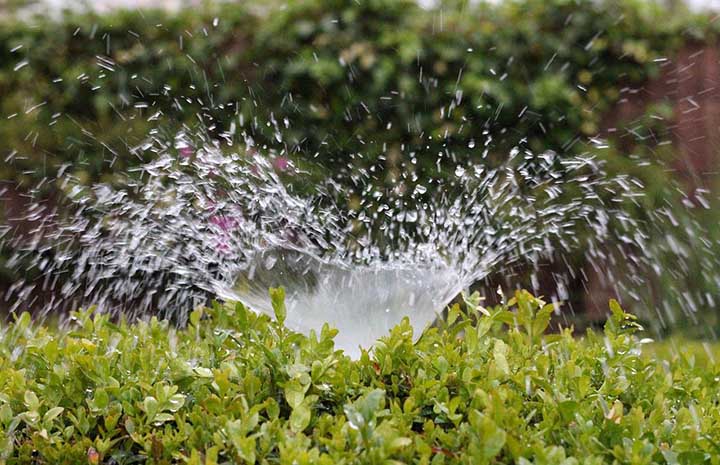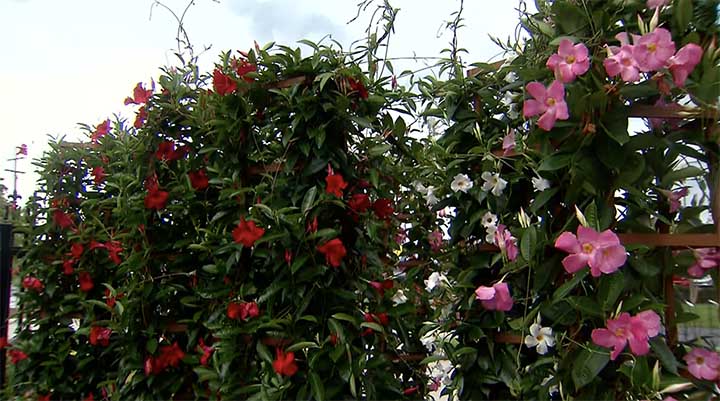Wild Mandevilla is a vine with dark green or variegated leaves and showy blooms. Newer hybrids are small mounding groundcovers. Outdoors, the flowers attract hummingbirds and butterflies. Indoors, they brighten any room. You may be wondering, “What do I need to know about Mandevilla blooms?”
Mandevilla flowers are beautiful. They are the reason most people plant Mandevilla.
Mandevilla Blooming: Everything You Need To Know
Mandevilla blooms from early summer to the first frost outdoors and can bloom all year indoors. However, they only bloom if they get all the care they need. Mandevilla needs to be in the proper soil, get the water and fertilizer they need, and be pruned each year to bloom the longest.
Table of Contents
Mandevilla Bloom Time: When Do Mandevilla Bloom?
Mandevilla naturally blooms in the summer until the first frost.
How Long Does Mandevilla Bloom?
Outdoors, Mandevilla bloom from early summer to the first frost.
Indoors, Mandevilla can bloom much longer. Sometimes indoor plants will bloom all year.
How Do I Keep a Mandevilla Blooming As Long As Possible?
The best way to keep a Mandevilla blooming as long as possible is to provide optimal care. Follow these recommendations to get as many blooms as possible.
Light
Mandevilla needs lots of bright light.
Outdoors, Mandevilla needs at least six hours of direct sunlight. If you live in a hot climate, plant the Mandevilla someplace where it gets morning light and afternoon shade.
Indoors, place the Mandevilla in bright, indirect sunlight all day. While a Mandevilla will tolerate less light, it may not bloom and will not produce as many blooms as it will in good light.
Soil
Outdoors, as long as the soil is well-drained, the Mandevilla is not too picky about the soil. Fertile soil with lots of organic matter is ideal.
Indoors, use a well-draining potting mix for houseplants.
Water

Mandevilla needs to be watered as often as it takes to maintain a moist but not soggy moisture level in the soil.
Outdoors, water an inch a week. If it rains, subtract the amount of rain from the water you give the Mandevilla that week. While an established Mandevilla can survive some drought, the vine will grow better and produce more flowers with an even moisture level. Reduce watering in the winter.
Indoors, water the Mandevilla when the surface of the soil is dry to the touch. Water until water comes out of the drainage holes. After fifteen minutes, empty any water in the saucer beneath the pot. The roots will rot if the soil is too wet. Reduce the water in the fall and winter.
Fertilizer
Too much fertilizer will make the Mandevilla grow a lot of foliage but few flowers. Be sure and follow the label directions on the fertilizer to avoid this problem.
Outdoors, you can spread a slow-release fertilizer around the Mandevilla each spring. If you prefer, you can use a water-soluble fertilizer every two weeks during the spring and summer. Do not fertilize in the fall and winter.
Indoors, use a water-soluble fertilizer formulated for indoor plants every two weeks in the spring and summer. Do not fertilize in the fall and winter.
Temperature
Outdoors, growth will start when the outside temperature is above 60 degrees. Temperatures below 40 degrees will cause the foliage to die back.
Indoors, keep your Mandevilla at 70 degrees or more during the day and 60-65 degrees during the night.
Humidity
Mandevilla is from humid subtropical and tropical areas. They like high humidity.
Outdoors, if you live in a dry area, mist the Mandevilla leaves in the morning to add humidity to the air.
Indoors, mist the leaves in the morning, use a humidifier in the room, or use a pebble tray to increase the humidity.
A pebble tray is a tray filled with pebbles and then filled with enough water so that just the tops of the pebbles are dry. Either put the Mandevilla on top of the pebbles or put the pebble tray next to the Mandevilla. As the water evaporates, it will create a humid microclimate around the Mandevilla.
Remember to keep the tray full of water.
Deadheading
When each flower wilts, cut it off the Mandevilla. Regular deadheading will help keep your Mandevilla blooming.
Repotting
If the Mandevilla is in a container, it will need repotting each year. Choose a pot with drainage holes and use fresh potting mix. You can repot the Mandevilla in the same pot as long as it is the size you want it to be, and you use fresh potting mix.
Pruning
In late winter, prune up to one-third of the Mandevilla branches. This will encourage vigorous growth and lots of blooms. For bushier plants, pinch the tips of the branches once they start growing.
Tips on Encouraging Mandevilla to Bloom
If your Mandevilla will not bloom even though you are providing everything it needs, you can do some things to encourage it to do so.
Epsom Salts
Dissolve a teaspoon of Epsom salts in water. Water the Mandeville twice with this mixture two weeks apart. Do not do this more than twice a year, or the salts will build up and kill the plant.
Once the Mandevilla starts blooming, flush the salts from the potting soil with water. Outdoor plants can be watered generously to flush the salts from the soil around them once they start blooming
Phosphorus
Phosphorus is the element that encourages blooms.
You can supplement the fertilizer you are using with a phosphorus fertilizer to help the plant bloom. Be cautious not to overuse phosphorus because it can poison your Mandevilla instead of helping it.
Why Won’t My Mandevilla Bloom?
Mandevilla won’t bloom unless all their needs are met. Here are some things to try to get the Mandevilla to bloom.
Sunlight
Make sure that the vines get plenty of sunlight. Either grow the Mandevilla on a trellis or put it in a hanging basket so that all parts of the vine get sunlight.
If growing as a ground cover, make sure nothing blocks the light falling on the plants. These plants won’t bloom well in the shade of a tree unless they get at least six hours of sunlight a day.
Outdoors, make sure there are no weeds around the plants. In a container, make sure other plants are not close enough to touch or shade the Mandevilla.
Water
Use a moisture meter to make sure the soil stays moist but not wet. Too little moisture is harmful, but overwatering will cause the roots to rot.
Fertilizer
Mandevilla is a heavy feeder in containers. Make sure you fertilize the plant every two weeks. Outdoors, fertilize each spring. Extra phosphorous will help blooms but do not use too much, or it will poison the plant. Too much nitrogen will encourage foliage growth at the expense of flowers.
Deadheading
If you do not cut off the spent blooms, the Mandevilla will not produce as many more flowers. Once some flowers set fruit, the plant reduces further blooms because it feels it has produced seeds for that year.
Frequently Asked Questions
Does Mandevilla Bloom All Summer or All Year?
Outdoors it blooms all summer. Indoors it can bloom all year.
How Do I Get More Flowers on My Mandevilla?
Follow the recommendations above.
Why Has My Mandevilla Stopped Blooming?
If the temperature drops, the Mandevilla will stop blooming outdoors. Indoors, the Mandevilla may need fertilizer, need to be deadheaded, need more or less water or sunlight, or need to be repotted.
Do You Deadhead Mandevilla?
Yes, deadheading Mandevilla will prolong the production of flowers.
In conclusion, Mandevilla will bloom all summer outside and can bloom all year inside. Proper care will keep your Mandevilla blooming as long as possible.
